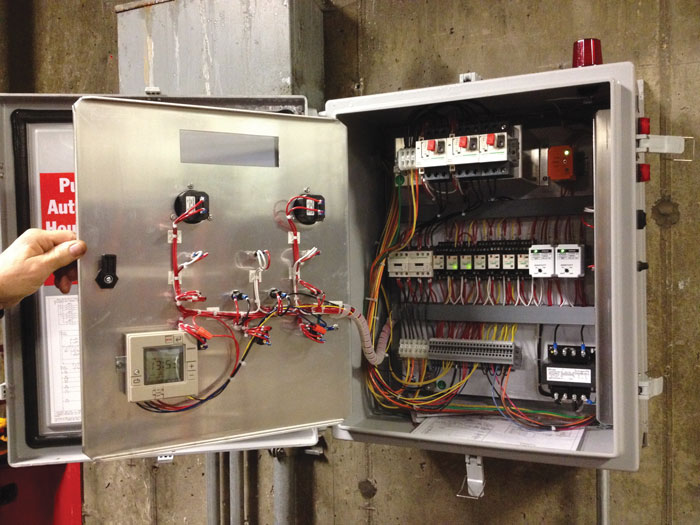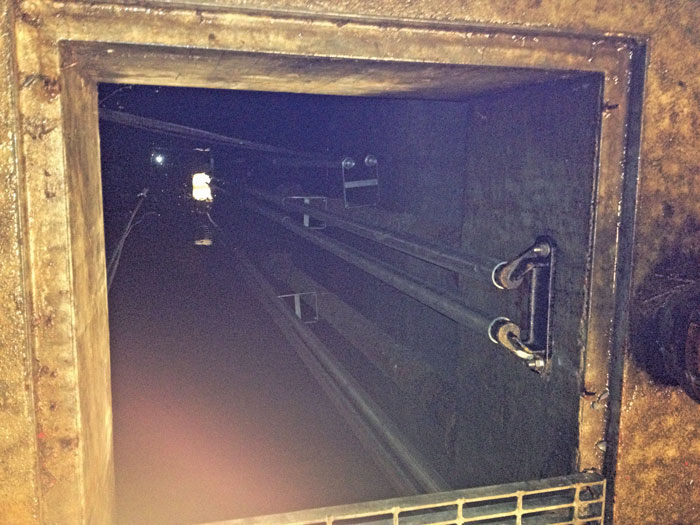Denver’s Coors Field—home to the Colorado Rockies Major League Baseball (MLB) franchise—began operations in March 1995 after two-and-a-half years of construction. Built in the “retro-classic” architectural style popular at the time, the stadium sports red brick and green painted exposed steel that embody the spirit of America’s favorite pastime.
 Image 1. Coors Field features an innovative drainage system. The infrastructure is designed to handle a 100-year flood because
Image 1. Coors Field features an innovative drainage system. The infrastructure is designed to handle a 100-year flood becauseof the field’s proximity to the South Platte River. (Images courtesy of BJM Corp.)
The structure was designed to blend with other buildings in the area, many of which are historic industrial structures that have been renovated and turned into lofts, shops and restaurants. The field itself is burrowed 21 feet below street level, keeping the stadium’s façade low-profile so not to overshadow the surrounding buildings.
The nostalgic feeling of the structure belies the fact that it was constructed with some of the most progressive technologies available at the time. Until recently, Coors Field was considered one of the most technically advanced ballparks in the country.
One innovative feature of the ballpark is its drainage system. The infrastructure was designed to handle a 100-year flood because of the field’s proximity to the South Platte River. Potential flooding aside, operations at
Coors Field require massive amounts of water.
After each event, the stadium is washed down using high-powered hoses and up to 200,000 gallons of water. Cleanup crews first pick up most of the large trash, but some items are missed or may fall into the drains. In addition to water for cleaning, the system collects runoff from the field during watering and whatever flows off the stands and field during wet weather.
“The only dirt that’s on the field is what’s on the sod,” said Mark Young, a heating, ventilation and air-conditioning (HVAC) technician in the engineering department at Coors Field. Underneath the 2 to 3 inches of dirt is a layer of sand and gravel designed to drain the field of as much as 4 to 5 inches of water an hour. This design allows the field to be ready for play quickly in the event of bad weather, but because there is so little dirt to hold in moisture, the field has to be watered daily.
Whatever the source, the water has to go somewhere. At Coors Field, it is collected in a massive vault under the parking lot at the stadium’s rear. It is estimated that the vault could hold up to 1 million gallons.
Because Coors Field was designed and constructed under the direction of a statutory Special District, it is subject to the Phase II rules of the National Pollutant Discharge Elimination System—part of the Clean Water Act. These rules require Coors Field to obtain and adhere to a General Municipal Separate Storm Sewer System (MS4) Discharge Permit that is administered by the Colorado Department of Public Health and Environment.
An integral part of the MS4 permit is the site’s Storm Water Management Plan (SWMP). The SWMP formalizes the many steps and procedures the facility implements to protect state waters from adverse effects related to pollution that could be picked up by stormwater generated on and around Coors Field.
The SWMP’s fundamental objectives are to provide for the effective management of stormwater runoff, minimize the potential for pollutants to enter stormwater runoff, and comply with and be protective of the water quality standards for the South Platte River.
The Challenge
During baseball season, the water—and any trash and debris collected with it—is pumped out of the vault and into the storm sewer system. In the off season, a much smaller amount of collected water is pumped out and diverted to one of several small detention ponds to evaporate.
The pumps that do the heavy lifting of moving the collected water out of the vault were replaced in May 2015. The original pumps were chopper pumps installed in 1998 and were showing signs of wear—moisture was getting into the motors. Since 1998, pump technology has come a long way. One goal of the replacement was to incorporate more modern technology into the system. Coors Field personnel wanted a pump that had good shredding capability and was made of durable materials.
When it became evident that the old pumps needed to be replaced—they were 17 years old and showing signs of wear—Young and James Leflar, an engineer and member of the Coors Field HVAC team, contacted Phoenix Sullivan, their representative at Denver Industrial Pumps.
The Solution
Sullivan recommended that the old chopper pumps be replaced with two submersible shredder pumps.
“The customer needed a pump that could handle debris getting into the vault/sump and not clogging the pump,” Sullivan said. “The (shedder pump we chose) has a cutting tool that cuts and shreds the debris ... allowing it to pass without clogging the pump.”
 Image 2. The contracted pump company was able to fabricate a custom VFD control panel at the ballpark’s request.
Image 2. The contracted pump company was able to fabricate a custom VFD control panel at the ballpark’s request. The original pumps operated on a highly specialized and outdated air bubbler system, but the new shredder pumps use a simple float system to turn them on and off.
The pumps operate on a lead-lag setup, Sullivan said. The floats prompt the first pump to turn on. If needed, the floats will also prompt the second pump to activate. Likewise, the floats shut the pumps off when the water level is sufficiently lowered.
For this installation, the target flow for each pump is approximately 350 gallons per minute (gpm) at 32 feet of total dynamic head. The new pumps can handle a maximum flow of 570 gpm, with a max head of 59 feet.
The two 7.5-horsepower (hp) pumps sit in a sump that is about 16 feet deep. They came with two cast-iron slide rail assemblies, four stainless steel intermediate guide rail brackets and 100 feet of 1.5-inch stainless steel pipe rails.
The new pumps also take advantage of advances in metallurgy and materials that allow all the pumps’ parts and components to be self-contained, Sullivan said. The only parts that may wear are the cutting bars, bearings and seals. Besides these parts, it would be realistic to expect these pumps to last 20 years, Young said.
 Image 3. The drainage system collects the runoff in a huge vault under the parking lot at the rear of the stadium. Debris such as peanut shells, straws and cups end up in the vault, which can hold up to 1 million gallons.
Image 3. The drainage system collects the runoff in a huge vault under the parking lot at the rear of the stadium. Debris such as peanut shells, straws and cups end up in the vault, which can hold up to 1 million gallons.The shredder pumps leave solids slightly larger than if passed through a grinder pump. The shredding action is created by a cutting impeller with a tungsten carbide tip operating against a spiral-shaped diffuser plate.
The pumps also feature a 304 stainless steel motor housing that will not wear out like aluminum motor housings when pumping sandy water, as well as three-seal motor protection. The lower seal is made of silicon carbide/silicon carbide, and the upper seal is made of carbon/ceramic. An additional lip seal has been installed above the impeller to help prevent abrasives such as dirt, silt and sand from entering the seal chamber.
The motor is further safeguarded by winding protection and National Electrical Manufacturers Association (NEMA) Class F motor insulation that allow motor temperature to rise to 230 F. An automatic switch turns the pump motor off if the temperature and/or amp draw gets too high. When the motor cools, the switch automatically resets and the pump turns back on.
An integral part of the new solution is a variable frequency drive (VFD) control panel customized to be compatible with Coors Field’s existing alarm panels in the security room. The Custom Duplex Control Panel has auxiliary contacts that allow communication with the existing system, which includes seal minders, elapsed time meters and dedicated auxiliary contacts for seal fail 1, seal fail 2, overload 1, overload 2 and high level.
The Outcome
The HVAC team at Coors Field feels confident that the newly installed pumps have prepared them to handle any curveballs that may come at them. “It does exactly what it’s supposed to do. It was a good install, and we haven’t had any issues with them,” Leflar said. “They’ve done what we asked them to do, and they met our criteria.”


